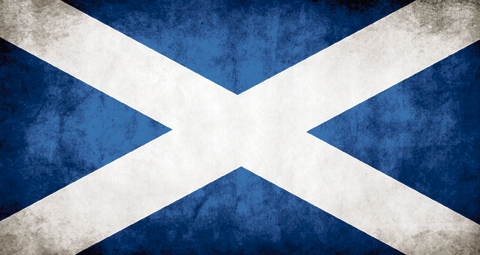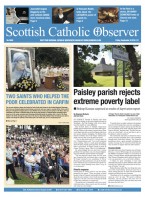November 29 | ![]() 0 COMMENTS
0 COMMENTS ![]() print
print

What is the Saltire?
On St Andrew’s Feast day, MICHAEL TURNBULL looks at the history of the Scottish flag that depicts the St Andrew’s Cross and signifies much more in Scottish minds past and present
As a young man, the future Roman Emperor, Constantine the Great (above inset) was based in York where his father, Constantius, was senior emperor of the West. Constantine accompanied his father north on his campaigns against the Picts but, in 306 AD, Constantius died in York and Constantine was immediately acclaimed emperor by the Roman Army, bypassing all the formal processes of election. In 312 AD Constantine faced a challenge from a rival Emperor, Maxentius. The battle-ground was on the outskirts of Rome, on each side of the River Tiber where the Milvian Bridge gave access to the city.
On the night before the Battle both Emperors concentrated on the enormous challenge before them. Constantine was at that time still a worshipper of the Roman sun god Sol. He looked heavenward for inspiration, towards the sun, when he suddenly witnessed an extraordinary sign in the sky. It was a Cross on fire with light. This event shown dramatically in Rome, a BBC film, where it is depicted as a smoke-filled burning comet.
It is more likely to have been a solar phenomenon in which the sun’s rays were refracted into the shape of a Cross. On the other hand, in his book ‘Constantine’ (2011) Professor Timothy Barnes of Edinburgh University concludes that it was a solar halo seen in the sky by Constantine and all his army. Constantine was already aware of Christian beliefs. In his entourage he had Christian advisers such as Bishop Eusebius who helped him to interpret the symbol in the sky. With their help he had a golden standard made and ordered his men to put the Chi Rho (the superimposed X P – the first two letters of the name Christ in Greek) upon their shields. The following day Constantine won the Battle of Milvian Bridge. Within a year he had legalised Christianity in the Edict of Milan, making it one of the official religions of the Roman Empire, lifting the penalties for blasphemy and treason from those who preferred to worship Jesus rather than the Roman Emperor.
But how does Scotland further connect with Constantine? Recent archaeological discoveries at the Roman fort in Inveresk near Musselburgh have included a Second Century funerary stone monument which shows the head of the sun god Sol, surrounded by triangular holes cut through the stone which would have allowed a candle placed behind to radiate light around the god’s head. This shows that Roman soldiers based in Scotland had a devotion to Sol at least 50 years before the Battle of Milvian Bridge.
Unlike the living St Andrew the Apostle, Constantine the Great had set foot in what is Scotland today. The importance of Constantine can be seen in the names of three early kings Constantine I OF Picts (AD 862–877, Constantine II (900–943) and Constantine III of Alba (995 to 997). Presumably they were named after the Roman Emperor in order to emphasise the power and authenticity of their dynasty by association.
The development of a national shrine at St Andrews which held some of the bones of the Apostle was intended to strengthen the Scottish kingship and would make possible the appeal of Scotland to the Pope contained in the Declaration of Arbroath on the basis that St Andrew was the brother of St Peter.
The first description we have of the Battle of Athelstaneford and the Vision of the Pictish King Angus (where he saw what we now call the Saltire Cross) is contained in two differing 12th century Latin manuscripts, now in the British Museum, compiled from earlier accounts. One manuscript states that a bright light shone down from heaven and a voice from on high spoke to them saying that it was Andrew, the apostle of Christ and that he had been sent by God to protect them.
Like Constantine, Angus is also said to have had a dream. The following day, the image of the Cross of Christ was seen in the sky, going before the Pictish army, shining down upon them and King Angus won. There colour of the sky is not mentioned.
In the 16th century, John Bellenden (1533-1587), Archdean of Moray and Canon of Ross translated Hector Boece’s The History and Chronicles of Scotland (1527) into Scots. Born in Dundee Boece (1465–1536) was a philosopher and first Principal of King’s College, Aberdeen. Bellenden writes that ‘ane schinand croce was sene in the lift, straucht above the army of Pichtis, not onlik to the samin croce that the appostil deit on’ (a shining cross was seen in the sky, straight above the army of the Picts, not unlike the same cross that the Apostle died on.’
Bishop John Leslie (1527-96) published his History of Scotland in 1578 and it in turn was translated into Scots in 1596 by James Dalrymple, a Scots monk of Regensburg in Bavaria. His version of the Vision of the Cross states that ‘the Croce, quhairupon S Andro diet, unto al thair present suddanlie appeirit, in viue and bricht colouris, in a maner, sett in the Aire…’
None of these versions of the story record the colour of the sky nor the precise shape of the Cross.
In his gripping novel Kenneth (1990) Nigel Tranter, the eminent Scottish novelist and historian describes King Angus’ vision of the Cross at the Battle of Athelstaneford as: “There, against the deep blue of the otherwise cloudless afternoon sky, was a cloud-formation in the exact shape of a cross —but a saltire cross, like the letter X, white against azure.”
Today, Mr Tranter’s commanding influence has succeeded in making this graphic account the authorised version of the Vision of the Cross.
But Mr Tranter, in his papers today held at the National Library of Scotland, was the first to point out that he wrote ‘as a perpetrator of romantic fiction,’ referring to King Angus’ experiences at the Battle of Athelstaneford as ‘romantic stories.’ So why was Tranter’s 20th century’s photographic realism assumed to be more historically accurate than the hauntingly simple twelfth century versions of the story?
The Saltire flag is blue and white but white is the heraldic symbol for silver and blue is the standard symbol for ‘sky.’ It is a two-dimensional version of a three-dimensional event—the Battle.
In fact the earliest recorded use of the Saltire is when the Scots king ordered his men to wear a white cross on a black background. Today we have forgotten the link between Athelstaneford and the Milvian Bridge where the Cross of Christ was seen in the sky and led to the legalisation and liberation of Christianity.
— Visitors who would like to visit the Chapel and Murthly Castle should contact George Leggat (Estate factor) on 01738 494 101 or email [email protected]











